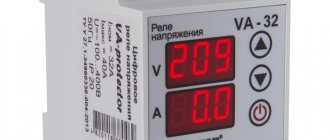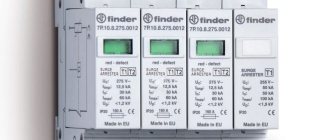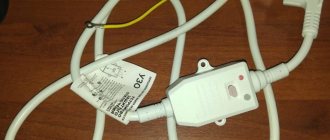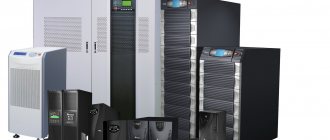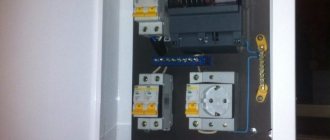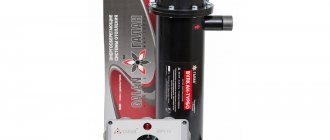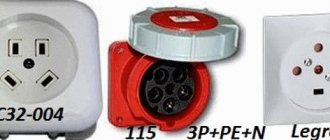The purpose of an RCD has already been discussed several times, and its installation in a modern household electrical network is definitely the most important protection for a person from electric shock. But how to choose an RCD? Based on what parameters? How to calculate a device for a particular protected consumer? Let's try to figure it all out.
To make the right choice of RCD, you need to understand its purpose, main characteristics and parameters. When you buy a device, pay attention to its case, all the important information is indicated there. So that these numbers and letters tell you something, we will analyze each of them separately.
Purpose
The most important thing to understand is that a circuit breaker protects the electrical network from overcurrents, and an RCD provides human protection. If, as a result of an insulation breakdown, potential appears on the body of an electrical appliance, touching it is likely to result in an electric shock. To prevent this from happening, immediately when a current leak occurs, the protective shutdown device will react and turn off the damaged section of the circuit.
It is important to know! RCDs do not protect against overloads and short circuits, so circuit breakers must be connected in series with them in the circuit.
Technical features of RCD selection
The technical side of the selection is as follows:
- It is necessary to select a device with the ability to open all phases and the neutral wire. This will protect against possible complications.
- Do not allow electrical contact between the working “zero” connected through the device and the protective “zero”.
- It is advisable to select a protection device taking into account a 30% margin for the rated load current.
- Some devices do not allow the use of aluminum wires.
Before starting work on installing devices, it is necessary to conduct a thorough inspection of the existing wiring and replace areas that do not meet the technical requirements for leaks.
Trademark
Speaking about the brand, we will essentially analyze the price-quality ratio. The fact is that there is an unspoken classification of all RCD manufacturers according to their territorial location - European models, Asian and Russian.
One way to spot a fake video:
Each of their products has its own characteristic features:
- Both a fire-fighting RCD and a device that protects people from electric shock produced in Europe will cost an order of magnitude more than models from Russia and China. But this price guarantees quality and reliability. It will not be amiss to know that some European companies, in addition to the main high-quality assortment, produce RCDs for the markets of other countries with the same reliability, but with reduced technical characteristics.
- Domestic manufacturers offer RCDs at a lower price than their counterparts from Europe, however, they meet all regulatory requirements of Russian standards. So far, Russian manufacturers' sales network is not so strong, and the devices themselves are not able to compete with Asians in price or with Europe in terms of quality.
- RCDs from Asian manufacturers are in greatest demand in the world. Some manufacturers from Asia enter into contracts with suppliers of products to the Russian market and in this case produce devices under the Russian brand.
Before choosing an RCD brand, decide what means you have for installing automatic protective equipment in an apartment or private house. Most preferred companies:
- Swiss "ABB";
- French Legrand and Schneider Electric;
- German "Siemens" and "Moeller".
Among domestic manufacturers, the most widely used products are:
- Kursky, average price and quality, the company gives a two-year guarantee for the RCDs produced, which indicates the reliability of the products;
- Moscow (“IEC”), products do not always receive positive reviews, however, the demand for it is high due to its low cost;
- Ulyanovsk, it is part of the group, which affects the quality of the products and, accordingly, the price;
- relatively young St. Petersburg, on the Russian market it represents the world-famous company “Schneider Electric”.
As for Chinese manufacturers, the RCDs they produce are a direct competitor to Russian devices. Price and quality are approximately at the same level, while the warranty period for Chinese goods is five years.
Selection of RCD by power
The shutdown device works in conjunction with the AV. There are rules on how to select an RCD and an automatic circuit breaker based on power for reliable joint operation.
To select an RCD based on power, it is necessary to calculate the RCD based on power and consumer lines. Then the current is determined by power, which serves to select the device with the nearest larger standard value.
Main settings
After the trademark, the main ratings and performance characteristics of the RCD are indicated on the body.
- Model name and series. Please note that here you will not always see the letters RCD; some manufacturers designate this device as a VDT (residual current switch).
- The value of the rated voltage and frequency. In the Russian power system, the operating frequency is 50 Hz. As for voltage, for a single-phase network in an apartment it is 220-230 V. For a private house, a three-phase network is sometimes needed and the operating voltage will be 380 V.
Characteristics of the RCD in the video:
- The rated operating current is the maximum value that the RCD is capable of switching.
- Rated differential current. This is the value at which the device is triggered.
- The temperature limits of the RCD operation are also indicated here (minimum - 25 degrees, maximum + 40).
- Another current value is the rated conditional short-circuit current. This is the maximum short circuit current that the device will withstand and not turn off, but provided that a suitable circuit breaker is installed in series with it.
- Nominal response time. This is the time period from the moment when a current leak suddenly occurs until it must be extinguished by all poles of the RCD. The maximum permissible value is 0.03 s.
- The RCD diagram must be drawn on the housing.
General tips for selection and installation
In addition to the criteria for selecting an RCD, there are general useful recommendations when purchasing and installing this equipment.
They will help you avoid making mistakes and immediately purchase a model suitable for a specific apartment or house.
Ignoring wiring installation rules and the absence of an RCD in the power supply circuit can lead to a fire throughout the house
Selection tips are as follows:
- It is recommended to take RCDs, which, when triggered, turn off not only the phase, but also the “zero”;
- There should be no grounded electrical appliances within the circuit controlled by the device;
- the device must operate during short-term voltage drops of 50% of the nominal voltage, which can occur in the first moments of a short circuit;
- RCD terminals must be made of slightly oxidized material and equipped with a reliable wire fixation system;
- preference when purchasing should be given to devices with short circuit and overload protection functions;
- The second level RCD need not be installed on safe groups of equipment, for example, on ceiling lighting sources;
- It is recommended to install devices with a threshold current flow of 10 mA on shower stalls and Jacuzzis;
- You should pay attention to the possibility of connecting aluminum wires to the device - some devices do not work correctly with them.
You can install the correctly selected RCD yourself. This process is not much different from installing a socket or switch.
It is important to carefully consider the wiring diagram and do as indicated on it.
Detailed information about the rules and diagrams for connecting RCDs in an apartment and house is presented in this article.
Leakage current shape
According to this parameter, all residual current devices are classified into three types:
- "A". Such a device trips when instantaneously occurring or gradually increasing current leaks have a sinusoidal variable or pulsating constant shape. This is the most common type of RCD. Due to the fact that it controls both alternating and direct current, it is more expensive.
- "AS". Also a common and more affordable device. It only works to generate alternating sinusoidal current leakage.
- "IN". This device is mainly used to protect industrial premises. In addition to the alternating sinusoidal RCD, it responds to the rectified and pulsating form of direct current leakage.
A completely logical question arises: in household networks, alternating current of a sinusoidal shape flows; can it be sufficient to install “AC” type devices everywhere? But if you take a closer look at the characteristics of modern household appliances, most of them have power supplies with electronic semiconductor components, reaching which the sine wave is converted into pulsed half-cycles. And if the leak is not of a sinusoidal nature, then the AC type RCD will not detect it and will not turn off.
That is why in the passports for many household appliances the manufacturer indicates through which RCD the connection must be made.
Tips for choosing an RCD on video:
Classification according to operating principle
All protective devices offered today on the market of related electrical equipment and accessories differ from each other in the type of operation. AC modules are installed in systems designed to protect household appliances from surges or slowly rising voltages and are triggered by alternating current.
Products A detect a constant pulsating current that increases in steps and react precisely to it. They are usually installed in homes for individual protection against extremes and combustion of washing machines, televisions and dishwashers. They have a structurally complex structure and are much more expensive than other elements of this class.
The most suitable place to locate an RCD in a residential building is an area close to a power source. Experts recommend placing the device directly next to the common meter
Units B are not suitable for homes or other residential areas. Their area of operation is enterprises and production workshops with a large amount of electronic equipment.
Selective devices S and G are triggered 1-4 seconds after a leak is detected. They are usually implemented in networks where several protective devices are present on one power line.
Operating principle
There are electronic and electromechanical RCDs.
The second is more expensive, but does not depend on the power supply. It will work as soon as a current leak occurs in the circuit.
An electronic device in its operation depends on an amplifier built into the electrical circuit. And in order for this amplifier to always be in working condition, it requires an external power source. In this regard, the reliability of operation is reduced.
When choosing an RCD for this parameter, we recommend giving preference to electromechanical devices.
Which residual current device to choose
Considering that the majority of electricity consumers require alternating current, it is worth choosing the AC type. For several objects, a group device must be used for protection.
To determine how to choose an RCD, the following must be considered:
- parameters for calculating leakage current for selecting RCDs;
- rated current values.
Selectivity
According to the selectivity of operation, residual current devices are of two types - “G” and “S”.
These RCDs are triggered after a certain period of time, called dwell time. They are used when several devices are connected in series. To protect outgoing consumer branches, devices are installed without a time delay, and at the input there are RCDs of type “G” and “S”. If a current leak occurs and the outgoing RCD does not respond, then after a certain time the device at the input should turn off.
For RCDs of type “S” the shutter speed is set in the range from 0.15 to 0.5 s, for type “G” - from 0.06 to 0.08 s.
Number of RCDs in the apartment
The number of protection devices is selected according to the number of points that need to be protected. In addition, it is necessary to provide a device for the group, installed at the entrance to the apartment behind the meter.
To reduce the number of products, it is possible to divide consumers into groups. For example: lighting group; a group of electrical household stationary appliances (refrigerator, hob); groups of especially dangerous rooms (bathroom, kitchen). Moreover, it is possible to use one RCD for a group of circuit breakers that protect certain consumers from overloads. An introductory RCD must be installed after the meter.
Two-level fire protection
For a wooden private house, guaranteeing fire safety is especially important. Therefore, in this situation, it is necessary to select an RCD, planning a two-level differential protection system. Its main purpose is that the protective function is divided:
- fire protection RCD ensures operation in case of large current leaks that contribute to fire;
- ordinary devices will prevent electric shock to a person with small leakage values.
Since the fire protection RCD has a high leakage current rating, it will not provide human protection on its own. Therefore, it is always installed together with an RCD, which has less leakage current.
Regardless of the value of the rated operating current and how many poles a fire protection RCD has, the leakage current parameter of such a device is 100 mA and 300 mA, otherwise it is no different from an ordinary one.
The connection diagram is carried out sequentially, we install a fire protection RCD closer to the power source (at the input), and universal ones on the outgoing branches of the protected wiring.
Visually about the fire protection RCD in the video:
Using an example, it looks something like this: we select the input RCD with parameters 63 A (nominal operating current) and 300 mA (leakage current), the remaining devices, respectively, are 40 A and 30 mA for the socket group, 25 A and 10 mA for the bathroom, 16 A and 10 mA for the lighting group.
The use of fire-fighting devices is also advisable in an apartment. Often the lighting group is left unprotected from leakage currents. With minimal probability, but high current leaks can occur in this branch, and if such an RCD is installed at the input, it will be a kind of safety net.
Operating principle of RCD
To prevent accidental electric shock from contact with household and industrial electrical appliances, a residual current device was invented.
It is based on a transformer with a toroidal core, which monitors the current strength at “phase” and “zero”. If its levels diverge, then the relay is activated and the power contacts are disconnected.
You can check the RCD by pressing the special “TEST” button. As a result, a current leak is simulated, and the device must disconnect the power contacts
Normally, any electrical device has a current leakage. But its level is so low that it is safe for the human body.
Therefore, RCDs are programmed to operate at a current value that can cause electrical injury to people or lead to equipment breakdown.
For example, when a child inserts a bare metal pin into an outlet, electricity will leak through the body, and the RCD will turn off the light in the apartment.
The speed of operation of the device is such that the body will not experience any negative sensations at all.
The RCD adapter is convenient because it allows you to quickly move between sockets. It is suitable for people who do not want to install stationary protective devices
Depending on the power of the connected equipment, the presence of intermediate protective devices and the length of the electrical wiring, RCDs with different limiting values of differential currents are used.
The most common protective devices in everyday life are those with threshold levels of 10 mA, 30 mA and 100 mA. These devices are sufficient to protect most residential and office premises.
It should be remembered that the classic RCD does not protect electrical wiring from short circuits and does not disconnect power contacts when the network is overloaded. Therefore, it is advisable to use these devices in combination with other electrical protection mechanisms, for example, circuit breakers.
Performing calculations
Let's try, using an example, to calculate which RCD still needs to be chosen for a particular protected branch of electrical home wiring.
In practice, it is not always possible to accurately calculate the total leakage current. Therefore, it is approximately determined by the following method: for 1 A of consumed load, take 0.4 mA of current leakage. You should also make a calculation based on the length of the phase wire - 10 μA is taken per 1 m.
Let’s say you need to choose the right RCD according to the power of the electric stove (3 kW). First, we calculate its load: 3000 W / 220 V = 13.64 A. Leakage current for the stove: 13.64 A x 0.4 mA = 5.46 mA. We perform the same calculation for a laid conductor, for example, 10 m: 10 µA x 10 m = 100 µA = 0.1 mA. In total, the leakage current is: 5.46 mA + 0.1 mA = 5.56 mA.
The resulting value of the sum of current leakage should not exceed 33% of the differential rated current of the RCD. And then the calculation from school mathematics lessons, we make an elementary proportion and get: 5.56 mA x 100% / 33% = 16.85 mA.
There is a special table of standard values of rated leakage currents, based on it, a 25 mA device is suitable for an electric stove.
You now know how to choose an RCD for an apartment or house, and you can determine the total calculated leakage current yourself. If you have even the slightest doubt about your knowledge and abilities, invite a professional electrician to do this work. Do not forget that the residual current device is a guarantee of your safety.
Rules for choosing protective devices
Before purchasing an RCD, you can visit electrician forums to seek advice on the reliability of a particular manufacturer.
However, it is necessary to select the maximum and threshold current, number of poles, mounting scheme and other technical parameters strictly individually, based on the characteristics of the room and electrical wiring.
Selecting a device by power
The residual current device does not control the power consumption of connected devices, but has limitations on the maximum current flow.
Therefore, it is important to know how to choose an RCD based on power, so that when installing a wiring diagram, you can correctly take into account the energy consumption of each group of rooms. After all, if the rated current exceeds the threshold value for the device, it may burn out.
In apartments and private houses, a one-level or two-level RCD system is usually used. Each of them has its own characteristics.
Single-level circuit with a single RCD - the rated current is calculated based on the total power of devices simultaneously connected to the network.
A circuit with a single RCD will protect the room from fire, and a person from most potential electrical injuries. Its disadvantage is the need to purchase a device with a high differential current threshold
For example, if the energy consumption of a washing machine is 2.4 kW, lighting is 1.1 kW and other devices are 2.8 kW, the RCD should pass (2400+1100+2800)/220=28 A.
In this case, with a rated current of the residual current device of 30 A, it will not burn out even with simultaneous operation of all household appliances and lighting.
When installing a single RCD, there may be a problem with finding the location of the breakdown. No matter in which room the current leak occurs, the entire apartment will lose electricity. Therefore, it is better not to save money and install an extensive protection system.
A single-level scheme is common in private houses, where RCDs are installed separately in each outbuilding: garage, greenhouse, workshop
Branched single-level circuit diagram for installing an RCD . In such a situation, the wires from the meter are branched into several groups using a special bus, each of which is controlled by a separate protective device.
The calculation of the rated current for each RCD in a branched single-level system is carried out separately. This takes into account the maximum power of devices potentially connected to the device.
For example, when connecting only a washing machine with an energy consumption of 2.4 kW to the RCD, its rated current will have to be at least 2400/220 = 10.9 A.
A two-level circuit is usually installed within one electrical panel and has no other disadvantages, except for the increased costs of purchasing an RCD
A two-level RCD system is considered optimal from the point of view of safety and maintainability.
Its first level is installed at the entrance to the apartment and ensures fire safety. The rated current of this protective device must be not lower than the maximum capabilities of the electricity meter.
The second level of energy protection is assigned to certain consumer groups. These could be rooms, floors, extensions, street lighting, single sockets.
Level 2 devices usually cost less and have a lower current rating. The sum of its values for all installed devices must be less than that of the basic RCD at the entrance to the room.
For example, with second-level protective devices with a rated current of 10 A, 16 A and 16 A, you will need to install a device with a minimum capacity of 10+16+16=42 A at the common input.
The advantage of a two-level system is the ability to turn off individual groups of electrical appliances in the presence of current leakage. This allows you to repair equipment or find problems with insulation in the wall without cutting off power to the entire apartment.
Calculation of the required differential current
Each RCD model is triggered at a certain level of differential current that occurs between the two conductors of the electrical cable. Therefore, it is important to know how to choose an RCD with safe characteristics for your home.
Electrical energy in minimal quantities can leak through normal wire insulation, which complies with electrical safety standards
When calculating the threshold differential current of an RCD, several parameters are taken into account:
- length of the wire to the device consuming electricity;
- natural leakage of current in equipment;
- power of devices.
The general formula for determining diphtoc is as follows:
IΔ=(0.4Icalc(A)+0.01Lwire(m))/1000
For example, let’s take the above-described diagram of electrical appliances and their power. Let the cable length to each group of household devices be 12 m.
The calculation of the RCD parameters for the above circuit will be as follows:
- IΔmash =(0.4*2800/220)+0.01*12=5.21 mA;
- IΔosv =(0.4*1100/220)+0.01*12=2.12 mA;
- IΔrose =(0.4*2400/220)+0.01*12=4.48 mA.
According to the recommendations, the threshold current of the device should be three times greater than the calculated differential one. Which is associated with increased electrical load in the first second of turning on household appliances.
If this rule is not followed, then frequent false alarms of the RCD are possible, which will create problems for consumers.
The threshold differential current is always indicated on the front panel of the RCD, because it is a key characteristic that affects its installation diagram
Therefore, for each group of electrical appliances under consideration, the minimum value of the threshold differential current will be as follows:
- 5.21 mA*3=15.63;
- 2.12 mA*3=6.36;
- 4.48 mA*3=13.45.
That is, for a washing machine and a group of sockets you will need an RCD with a 30 mA current, and for a lighting group a 10 mA device will be sufficient.
Such characteristics of the devices will ensure the normal functioning of the equipment and protect people from electric shock. It is not recommended for these purposes to install an RCD with a parameter higher than 30 mA.
With a two-level scheme, the leakage current of the main protective device located at the entrance to the room is selected within the range of 100-300 mA.
These RCDs are triggered when old or damaged insulation inside the walls breaks down. Thus, the premises are protected from fire in case of hidden electrical wiring defects.
RCD response time
In a two-level system, the occurrence of significant current leakage can lead to the operation of the protective device at both levels.
To eliminate this situation, a selective protective device can be installed as a base device. Its response time is 150-500 ms, which is several times longer than that of a standard RCD (20-40 ms).
The response time of the RCD depends on the level of the leakage current: the higher and more dangerous it is, the faster the power contacts are disconnected (+)
With this selection of devices, only the power supply on the second level will be turned off, which will not lead to a loss of electricity in the entire apartment.
As for conventional RCDs, the shorter their reaction time, the safer they are. This fact must be taken into account when purchasing them.
Choosing a reliable manufacturer
The direct protective function of an RCD depends little on its manufacturer. A device from any company, with the exception of clearly defective models, will turn off the power supply when the differential current exceeds the threshold value.
The disadvantages of protective devices may be the following:
- false positives;
- increased buzzing;
- heating during operation;
- fragility of the case, which can lead to damage during installation;
- short warranty period.
The more reliable and reputable the RCD manufacturer is, the fewer of the listed disadvantages its equipment will have.
In terms of reliability, RCDs from well-known domestic companies are not inferior to European manufacturers, so it’s worth taking a closer look at their model range
However, as quality increases, so will the price.
The most reliable manufacturers of protective devices are:
- Legrand;
- ABB;
- AEG;
- KEAZ;
- Schneider Electric;
- Siemens;
- DEKraft;
- General Electric.
When purchasing an RCD, you should remember that this device is not installed to comply with building codes, but to preserve the health and lives of loved ones.
Therefore, you should not buy products from dubious manufacturers. They may not only fail to work, but also lead to a fire hazard.
There are other criteria for selecting residual current devices, but they are of much less importance for consumer safety.
Installation diagram
Connecting an RCD in a single-phase and three-phase electrical network, where a phase L-conductor and an N-conductor are used, often uses the option of switching on protection without a grounding system. A similar procedure exists, as a rule, in old housing stock.
RCD diagram in network 220 with grounding
Modifications for connecting the device to a single-phase network:
- General protection 220 V network in a house without a ground loop. The device is mounted in an electrical panel. It is located between the introductory machines and other single-lane AVs. The device guarantees the protection of absolutely all outgoing power lines in the event of a leakage current. This option of connecting protection without grounding has the only drawback - since the protective device is common, in the event of an accident it will be impossible to correctly determine which power line the accident occurred on.
- General RCD for 220V, electric meter and grounding system.
It is necessary to pay attention to the fact that in the newest protective systems, in order to correctly connect the protection, it is not necessary to install supply lines only on the top or bottom of the device. They allow both options, therefore, in order to avoid mistakes, you will first need to carefully study the technical documentation when connecting the RCD.


